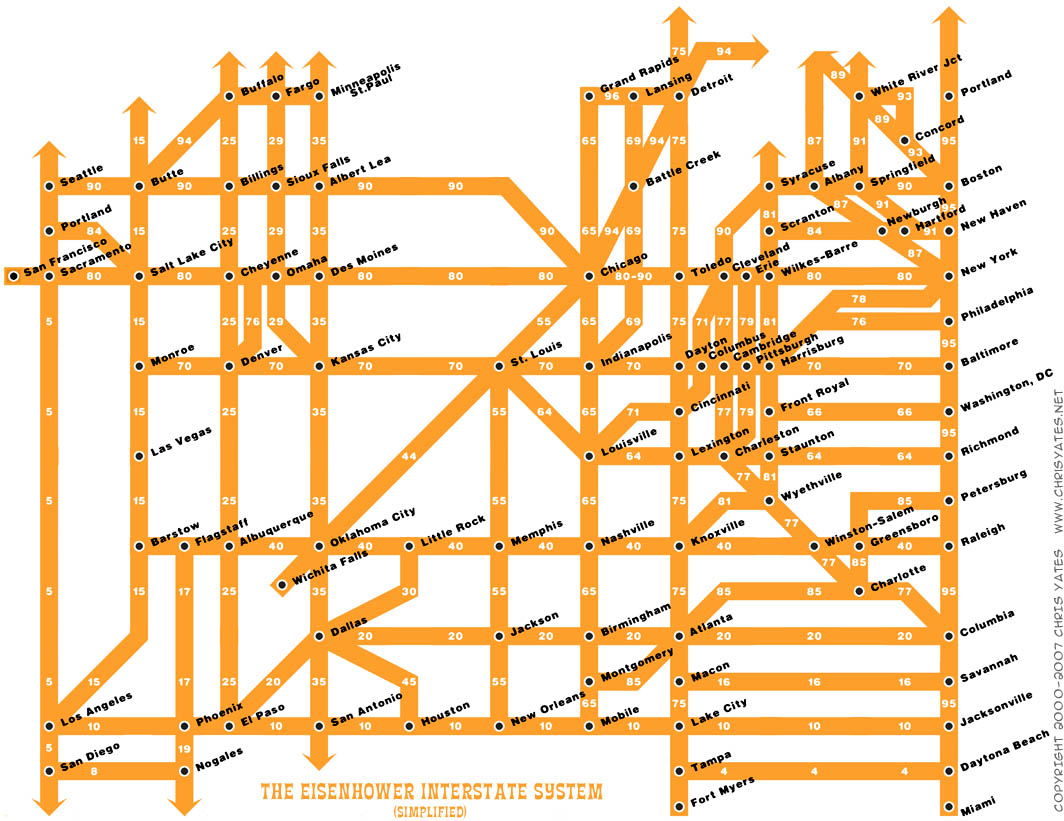The Eisenhower Interstate System Simplified
#1
Guest
Posts: n/a

http://www.fhwa.dot.gov/programadmin/interstate.cfm


History
Commemorative sign introduced in 1993. Though the system was established during Dwight D. Eisenhower's presidency, the five stars commemorate his rank as General of the Army during World War II.
Commemorative sign introduced in 1993. Though the system was established during Dwight D. Eisenhower's presidency, the five stars commemorate his rank as General of the Army during World War II.
The Interstate Highway System was authorized by the Federal-Aid Highway Act of 1956, popularly known as the National Interstate and Defense Highways Act of 1956. It had been lobbied for by major U.S. automobile manufacturers and championed by President Dwight D. Eisenhower, who was influenced by his experiences in 1919 as a young soldier crossing the country (following the route of the Lincoln Highway) and his appreciation of the German autobahn network as a necessary component of a national defense system. [6] In addition to facilitating private and commercial transportation, it would provide key ground transport routes for military supplies and troop deployments in an emergency.
Initial federal planning for a nationwide highway system began in 1921 when the Bureau of Public Roads asked the Army to provide a list of roads it considered necessary for national defense, resulting in the Pershing Map.[7] Later that decade, highways such as the New York parkway system had been built as part of local or state highway systems. As automobile traffic increased, planners saw a need for such an interconnected national system to supplement the existing, largely non-freeway, United States Numbered Highway system. By the late 1930s, planning had expanded to a system of new superhighways. In 1938, President Franklin D. Roosevelt gave BPR chief Thomas MacDonald a hand-drawn map of the U.S. marked with eight superhighway corridors for study.[7] The publication General location of national system of interstate highways maps out what became the Interstate System, and is informally known as the Yellow Book.[8]
Although construction on the Interstate Highway System continues, the removal of the last traffic signal on Interstate 90 in Wallace, Idaho, on September 15, 1991 is often cited as the completion of the system. The initial cost estimate for the system was $25 billion over 12 years; it ended up costing $114 billion (adjusted for inflation, $425 billion in 2006 dollars[9] and taking 35 years to complete.[10]
Due to the cancellation of the Somerset Freeway, Interstate 95 is discontinuous in New Jersey. When the Pennsylvania Turnpike/Interstate 95 Interchange Project concludes in or around 2009, the last section of the original plan will be completed.
#2
Lexus Fanatic
iTrader: (20)
That first diagram's very cool.
Just one thing I don't understand - why is Buffalo up near Fargo?
Just one thing I don't understand - why is Buffalo up near Fargo?

Thread
Thread Starter
Forum
Replies
Last Post
avanchieri
GS - 4th Gen (2013-2020)
4
08-23-16 01:22 PM
DemosISF
IS F (2008-2014)
1
02-17-10 11:38 AM



